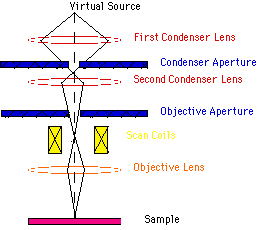Scanning Electron Microscope (SEM)

SEMs are patterned after Reflecting Light Microscopes and yield similar
information:
Topography
- The surface features of an object or "how it looks", its texture; detectable
features limited to a few manometers
Morphology
- The shape, size and arrangement of the particles making up the object that
are lying on the surface of the sample or have been exposed by grinding or
chemical etching; detectable features limited to a few manometers
Composition
- The elements and compounds the sample is composed of and their relative
ratios, in areas ~ 1 micrometer in diameter
Crystallographic Information
- The arrangement of atoms in the specimen and their degree of order; only
useful on single-crystal particles >20 micrometers
A detailed explanation of how a typical SEM functions follows (refer to
the diagram below):

- The "Virtual Source" at the top represents the electron gun, producing
a stream of monochromatic electrons.
- The stream is condensed by the first condenser lens (usually controlled
by the "coarse probe current knob"). This lens is used to both form
the beam and limit the amount of current in the beam. It works in conjunction
with the condenser aperture to eliminate the high-angle electrons from the
beam
- The beam is then constricted by the condenser aperture (usually not user
selectable), eliminating some high-angle electrons
- The second condenser lens forms the electrons into a thin, tight, coherent
beam and is usually controlled by the "fine probe current knob"
- A user selectable objective aperture further eliminates high-angle electrons
from the beam
- A set of coils then "scan" or "sweep" the beam in a grid fashion (like
a television), dwelling on points for a period of time
determined by the scan speed (usually in the microsecond range)
- The final lens, the Objective, focuses the scanning beam onto the part
of the specimen desired.
- When the beam strikes the sample (and dwells for a few microseconds) interactions
occur inside the sample and are detected with various instruments
- Before the beam moves to its next dwell point these instruments count the
number of interactions and display a pixel on a CRT whose intensity is determined
by this number (the more reactions the brighter the pixel).
- This process is repeated until the grid scan is finished and then repeated,
the entire pattern can be scanned 30 times per second.
[TEM]

